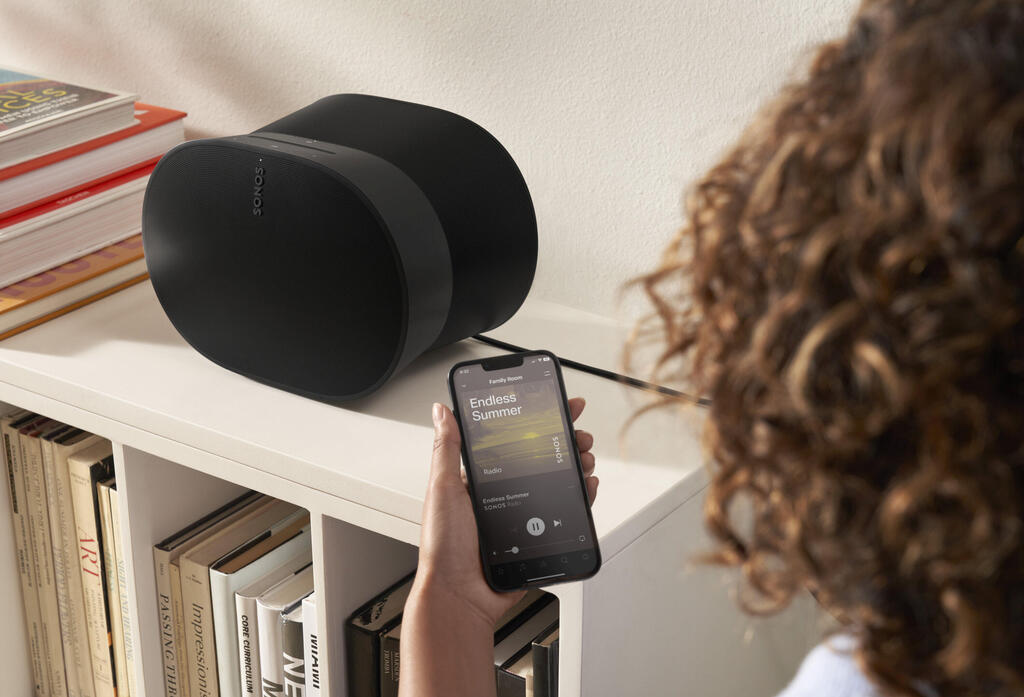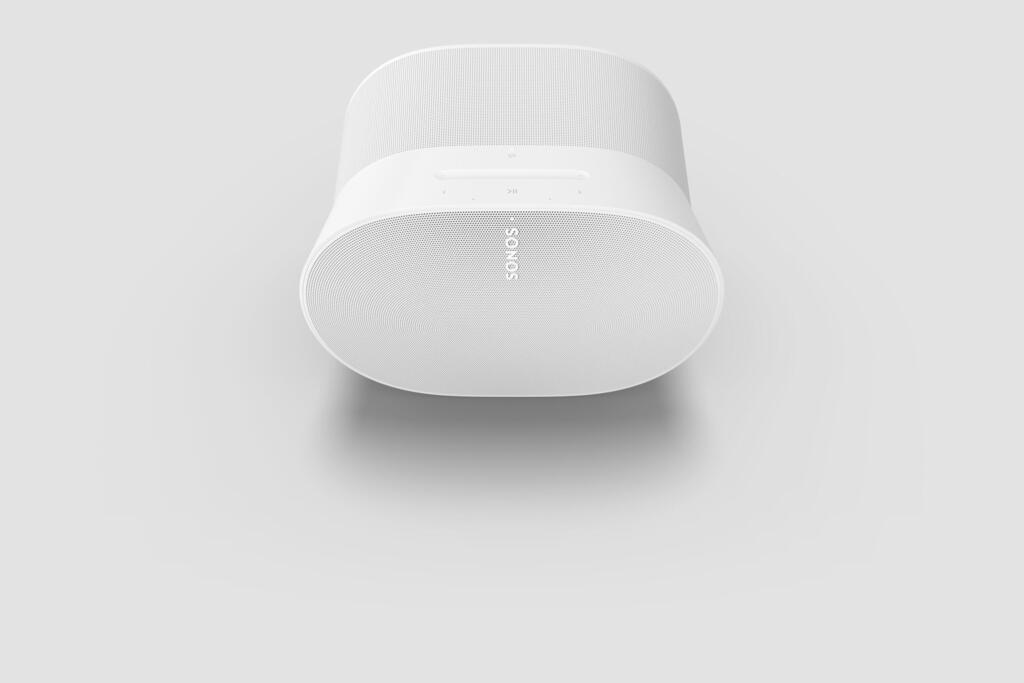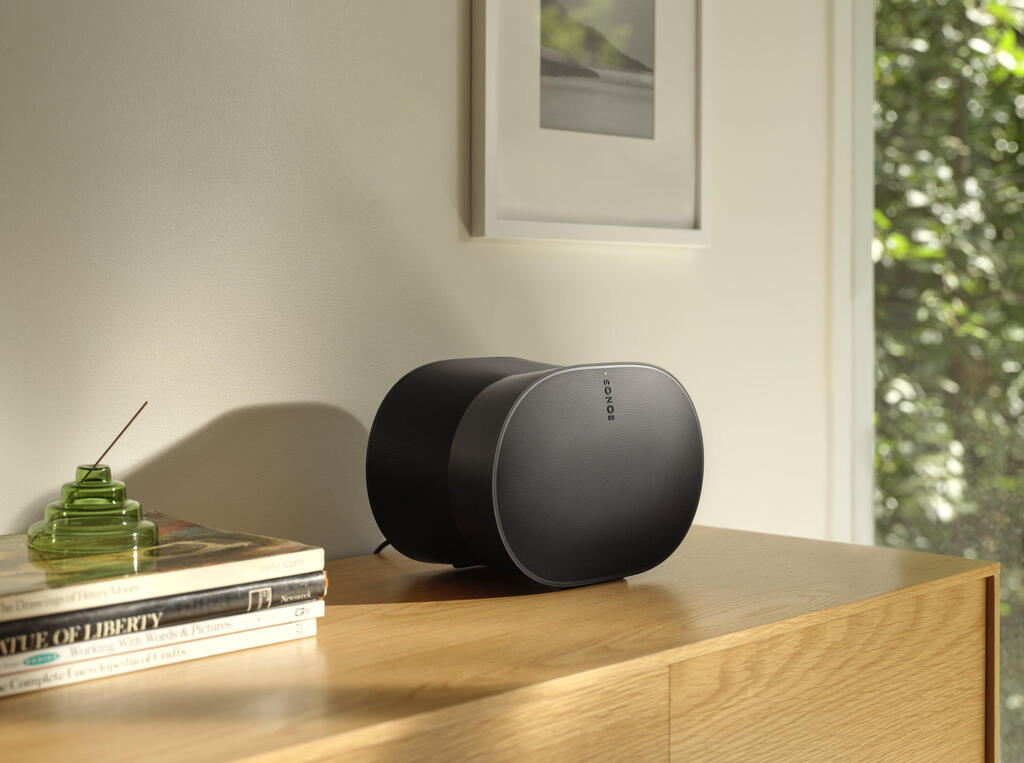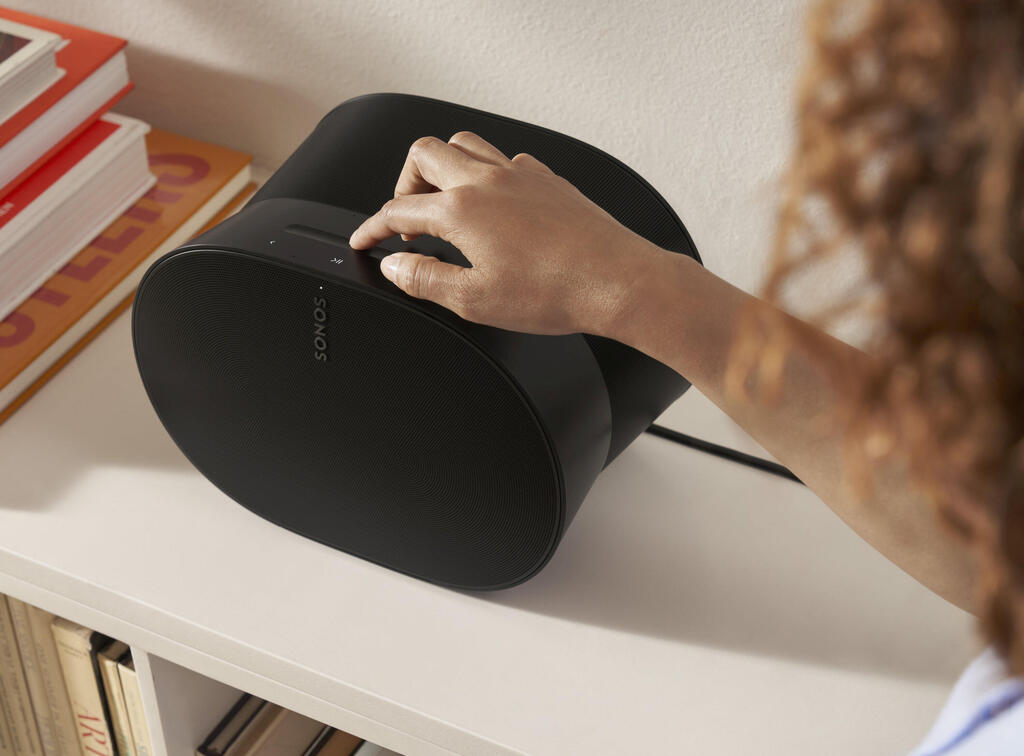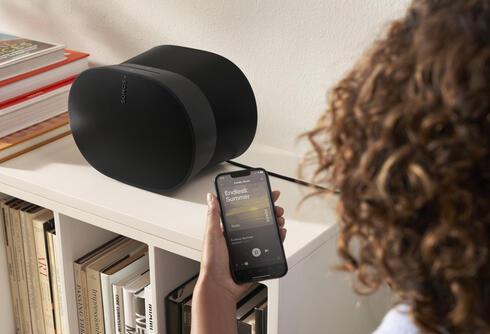
Gadget review
Sonos Era 300: An excellent speaker that’s ahead of its time
"The new Sonos speaker offers a different listening experience with "spatial sound" - technology that spreads the sound around the room," writes CTech’s gadget reviewer Itai Smuskowitz. "It does it excellently, but there is still not much quality content that allows it to realize its full potential"
How can you take seriously the announcement of a company that is launching new speakers when they claim that "sounds and music come alive with unparalleled clarity and depth," and that "spatial audio (an explanation is coming soon) is the next evolution in listening - creating a sound experience that envelops you in music"? Faced with such announcements, I find myself thinking - okay, this might be a quality speaker, but let's not get carried away. Even Apple, for example, declares every year that its new iPhone is the best it has ever produced (and the same goes for the iPad, of course).
But this time it's different. The Era 300, the new speaker from Sonos, is very impressive indeed and delivers on these promises - when everything works as it should. Yes, there are a few asterisks here, and it's not just dependent on Sonos.
How to create a sound bubble
First of all, what is audio or spatial audio? It refers to the technology by which the sound is dispersed throughout the room and creates a feeling that it surrounds the listeners, therefore this function is also called 3D music. We are talking about Spatial Audio or Immersive or 3D. It's not just a right-left division like in stereo, nor is it a surround sound that surrounds the listener. The result should be a kind of bubble that surrounds the listeners, with sounds coming from all directions.
The new Sonos speaker supports Dolby's Atmos format, which offers spatial audio, launched about a decade ago and is used in cinemas around the world. In recent years, this format has also reached Netflix and Apple's music service, among others.
Visual illustration of sound dispersion in Dolby Atmos
The Era 300 is a large and massive device, weighing about 4.5 kg, with an elliptical design and inside there are two tweeters, four woofers and six amplifiers that are all directed forward, to the sides and up to spread the sounds and create the effect of spatial audio. Sonos explains that you should not put this speaker in a closed place and you should leave enough free space above it.
The installation includes a connection to electricity and running the Sonos app - from there the process flows smoothly, even for those who have never used the Sonos app or speaker before. Connect the speaker to the home wireless network and adjust the sound according to the location - the speaker plays a series of sounds, picks up their dispersion using its microphone and off you go.
You can add to the application all the music, podcast and audiobox services you are registered to and also connect to radio stations from around the world, through the Sonos radio service. You can install the application on several devices at the same time and the information is synchronized between all of them - if you have added Apple Music to the Sonos application through an iPad, for example, the service will also be available on an Android device that did not have the Apple application installed.
Now you can search for songs, albums and playlists in the Sonos app and filter the results by source - from Spotify, Apple Music or YouTube Music, for example. You can also schedule an alarm clock with certain music, adjust the sound manually and more.
If you have another Sonos speaker, you can control both through the app - play the same content on two different speakers, set a different volume for each of them, play a different song on each speaker, and more.
On the Era 300 itself there are also touch buttons to increase and decrease the volume, among them there is a touch strip that you can slide in the direction of the desired volume and there are also buttons to move or stop the music.
The Era also includes a microphone, as mentioned, for activating a smart assistant, but in the absence of official support for Amazon's Alexa and Google Assistant in Israel, you will have to make do with Sonos' built-in service and local control of the device - play a song, stop it, increase or decrease the volume, and so on. That is, you will not be able to control other smart devices through it (except for another Sonos speaker) or perform searches. Still worried about your privacy? On the back of the speaker there is a button to turn off the microphone.
The format is not new, but its adoption is still partial
The main problem is not with Sonos. In order to enjoy spatial sound, it is not enough to take the speaker out of the box and connect it to the home network - you need compatibility with the standard in every part of the chain. That is, you need a song in the appropriate format, which will be available on a music service that supports this format and a suitable speaker.
Spotify, for example, does not yet support Dolby Atmos, Apple Music does - but not all of its songs are available in this format. You can also find songs in the same format on Amazon's music service, but officially it is not available in Israel and it cannot be added to the services linked to the speaker.
Apple Music has playlists of songs that have been mixed appropriately for the Dolby format, according to different genres - you can just search for Spatial and get to them. But there is a problem of unevenness: there are songs and compositions that have been mixed successfully and then the effect is clear and very impressive, and there are songs that sound better than in a normal format, but if this was a boxing match then the victory would be by points and not in a crushing knockout.
As mentioned, all this is not the fault of Sonos and when everything works, the result is really impressive. I listened to the Era 300 alone, without any additional speakers connected to it, in a large space where the sounds could have spread out too much and gotten lost, and there were still really jaw-dropping moments, (try How Insensitive performed by Astrud Gilberto, for example). It's not just the sounds that "come to life" as announced by Sonos at launch - also artists, including those who are no longer with us, suddenly sound as if they are right next to you.
Thanks to the dispersion of the sounds inside the room, the volume of a song in the "spatial" format is higher, and my living room seems to have become a concert hall, a jazz club or a performance space. I went outside to check that there would be no complaints from the neighbors and the volume was reasonable.
To be safe, I switched between the same song on Spotify, which as mentioned does not support "spatial sound", and an upgraded version (or vice versa) and the feeling is that this is simply an unfair comparison - the differences are clear and prominent. Each musical instrument gets its place, the sound has added depth and you can notice details that you don't hear during normal listening.
There are also some issues
The Era 300 alone is not enough for a home theater system - to enjoy "spatial sound" on the TV you also need to add a suitable sound projector from Sonos. In the meantime, you can make do with connecting the Era 300 to the TV via Bluetooth as a normal speaker.
The speaker is smart, the design is meticulous and it's clear that thought was put into the design, but that doesn't mean there aren't problems as well.
The Era 300 includes a USB-C connection and Sonos explains that it is not intended for connecting the speaker to electricity or charging other devices. So what is the purpose? For connecting wired Internet or other audio devices with a 3.5 mm cable, using dedicated adapters that are sold separately. They could have simply added a standard audio jack to the speaker and also a wired connection to the home network instead of creating a , cumbersome, workaround, and expensive solution. Maybe they will fix it in the next model.
As mentioned, the installation is user-friendly, but the application is not always - the system menu does not refer to the settings of the application itself, as one might assume, but to the settings of the speaker(s). If you choose to move the speaker to another location, it is recommended to reorient the sound, but how do you get to it again after the first installation? You can find it in the Trueplay menu (which is in a submenu within the system), a name that will not hint at the function it activates for those who are not familiar with Sonos.
You can make do with the application to select songs and filter the results, but if you do not choose songs from spatial audio playlists, it is difficult to know in advance in which format the album or song will be played.
I used the app mostly on Android, and after I selected a song from the middle of the playlist the menu jumped back to the beginning of the list and it took a few seconds to load - not bad, but a bit annoying.
Summary
The Era 300 is truly an excellent speaker, even in normal use, but the highlight is the spatial audio, which offers a different experience and is ahead of its time. However, the number of songs available in this format is still limited, and some of the songs that have been upgraded were not successfully processed. In such conditions, the Era 300 cannot always realize its full potential.
The speaker's success and the decision of whether to purchase it depend on the state of your bank account, the rate at which the music industry will adopt Dolby Atmos, and the quality of the song mixes.








